Biathlon
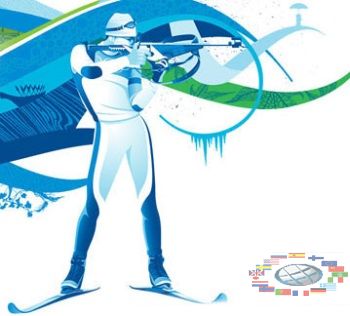
Biathlon is a breathtaking winter sport, which combines skiing race with a rifle shooting.
Rules and Equipment
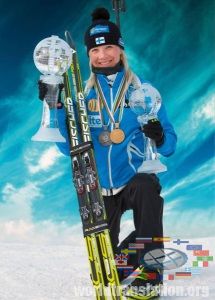 Biathletes use the free style of skiing. The maximum length of skis is not limited, but they must not be shorter than biathlete height minus 4 cm, weight - not less than 750 g., minimal width of 4 cm. So most often are used common skis and poles for cross-country skiing (in turn ski poles length must not be longer than the biathlete height; sticks which change their length and reinforce push are banned).
Biathletes use the free style of skiing. The maximum length of skis is not limited, but they must not be shorter than biathlete height minus 4 cm, weight - not less than 750 g., minimal width of 4 cm. So most often are used common skis and poles for cross-country skiing (in turn ski poles length must not be longer than the biathlete height; sticks which change their length and reinforce push are banned).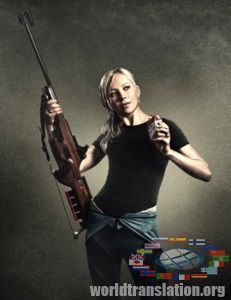 The minimum weight of the applicable rifle is of 3.5 kg, during the race rifle is located on the biathlete's back. Are banned the automatic and semi-automatic weapons. For a rifle scope is banned effect of target increasing, instead is used dioptric sight and and annular foresight, which athlete should combine with a black circle target during the shooting. Bullets has caliber of 5.6 mm.
The minimum weight of the applicable rifle is of 3.5 kg, during the race rifle is located on the biathlete's back. Are banned the automatic and semi-automatic weapons. For a rifle scope is banned effect of target increasing, instead is used dioptric sight and and annular foresight, which athlete should combine with a black circle target during the shooting. Bullets has caliber of 5.6 mm.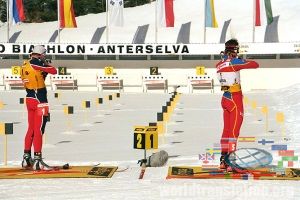 The distance to the targets on the shooting range is of 50 meters. Target are black (5) on one white plate. After contact targets are closed by white valve - it allows the athlete to immediately see the result of the shooting. Target is a black circle in the deepening of the plate, with a diameter of 115 mm. When shooting in the standing position is counted hit into any area of the circle, and when shooting in the prone position is counted hit only in a black circle with a diameter of 45 mm, which center coincides with the center of a large circle (of 115 mm).
The distance to the targets on the shooting range is of 50 meters. Target are black (5) on one white plate. After contact targets are closed by white valve - it allows the athlete to immediately see the result of the shooting. Target is a black circle in the deepening of the plate, with a diameter of 115 mm. When shooting in the standing position is counted hit into any area of the circle, and when shooting in the prone position is counted hit only in a black circle with a diameter of 45 mm, which center coincides with the center of a large circle (of 115 mm). 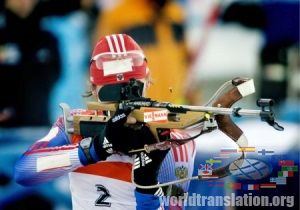 Also hit is counted in a case of a bullet ricochet in the circle, after a bullet hit to the edge of the plate, then biathletes say "clearance passed". At each firing line in all individual events there are 5 shots at the disposal of biathletes. In the relay athlete can use additional bullets (3 bullets per firing line) which he recharges manually. The most popular are: German-made rifles Anschütz and Izhevsk rifle " Biathlon" made in Russia.
Also hit is counted in a case of a bullet ricochet in the circle, after a bullet hit to the edge of the plate, then biathletes say "clearance passed". At each firing line in all individual events there are 5 shots at the disposal of biathletes. In the relay athlete can use additional bullets (3 bullets per firing line) which he recharges manually. The most popular are: German-made rifles Anschütz and Izhevsk rifle " Biathlon" made in Russia.
Types of races
Now international biathlon competitions are carried out in 6 types of races:
- pursuit;
- individual race;
- mass start;
- sprint;
- relay;
- mixed relay.
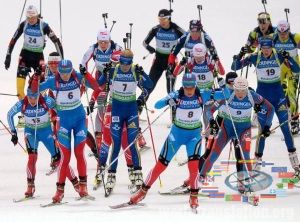 The longest race in biathlon is individual race (20 km for men and 15 km for women). Its followed by mass start (15 km for men, 12.5 km for women). The smallest is sprint (10 km for men and 7.5 km for women). In the relay the shortest distance is 7.5 km for men and 6 km for women at every stage. Pursuit is intermediate between the sprint and the mass start (12.5 km for men and 10 km for women).
The longest race in biathlon is individual race (20 km for men and 15 km for women). Its followed by mass start (15 km for men, 12.5 km for women). The smallest is sprint (10 km for men and 7.5 km for women). In the relay the shortest distance is 7.5 km for men and 6 km for women at every stage. Pursuit is intermediate between the sprint and the mass start (12.5 km for men and 10 km for women).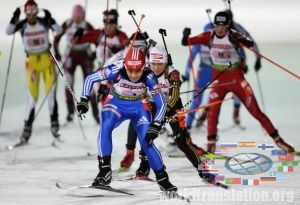 Biathlon races can be individual and team ( relay). In the individual race start on all biathletes and are recorded only their personal results. During the relay start on team members (4 biathletes), having passed his stage 1-st participant passes the baton to the next participant, and the result is passing of the race by whole team. Pursuit, individual race, mass start and sprint refer to personal races, and relay and mixed relay refer to team races.
Biathlon races can be individual and team ( relay). In the individual race start on all biathletes and are recorded only their personal results. During the relay start on team members (4 biathletes), having passed his stage 1-st participant passes the baton to the next participant, and the result is passing of the race by whole team. Pursuit, individual race, mass start and sprint refer to personal races, and relay and mixed relay refer to team races.
In biathlon, all races can be divided into: races with interval and with the general start. Team races are races with general start (this refers to relay participants, 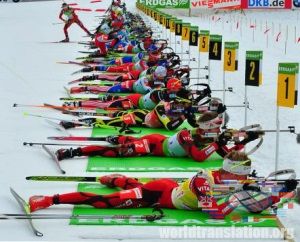 which start on 1-st, all the other competitors start on with intervals which their colleagues by team brought them). In the individual races only mass start begins with a general start. Pursuit, individual race and sprint start with interval start. In the individual race and sprint this interval is the same for all biathletes (30 - 60 seconds), and in the pursuit - this interval is equal to the time which biathlete brought from qualifying race ( sprint).
which start on 1-st, all the other competitors start on with intervals which their colleagues by team brought them). In the individual races only mass start begins with a general start. Pursuit, individual race and sprint start with interval start. In the individual race and sprint this interval is the same for all biathletes (30 - 60 seconds), and in the pursuit - this interval is equal to the time which biathlete brought from qualifying race ( sprint).
The penalty for misses in the individual race is 1 minute, in other races - the penalty loop (150 meters). 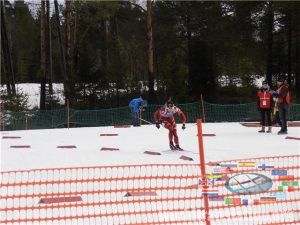 In the relay for closing of targets athlete is given 5 major and 3 additional bullets. So if the biathlete will not close all 5 targets after 5 shots, he manually recharges each of three additional bullets. (if after eight shots remain open targets - then athlete runs penalty loops (as many loops as open targets remain).
In the relay for closing of targets athlete is given 5 major and 3 additional bullets. So if the biathlete will not close all 5 targets after 5 shots, he manually recharges each of three additional bullets. (if after eight shots remain open targets - then athlete runs penalty loops (as many loops as open targets remain).
Shooting.
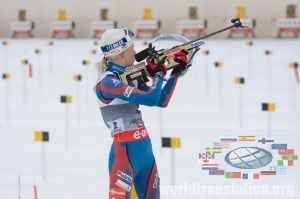 At each stage of team racing and in sprint athletes shoot 2 times - 1st time in the prone position, then from a standing position. In the pursuit and mass start there are 4 shooting: first 2 - lying, then - two standing. In the individual race there are also 4 shooting, but shooting is as follows: the 1st and 3rd shooting ranges - lying, on the 2nd and 4th shooting ranges - standing.
At each stage of team racing and in sprint athletes shoot 2 times - 1st time in the prone position, then from a standing position. In the pursuit and mass start there are 4 shooting: first 2 - lying, then - two standing. In the individual race there are also 4 shooting, but shooting is as follows: the 1st and 3rd shooting ranges - lying, on the 2nd and 4th shooting ranges - standing.
Competitions
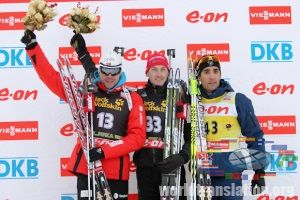 Biathlon is represented at the Winter Olympics (the competition is conducted in: Pursuit, Individual race, Mass Start, Sprint and Relays - women and men).
Biathlon is represented at the Winter Olympics (the competition is conducted in: Pursuit, Individual race, Mass Start, Sprint and Relays - women and men).
Among cup biathlon competitions the most significant is the World Cup. It is held for men and women, and consists of a series of races, which take place at different stages. Each stage includes a 3 - 4 men's and women's races. During the season is conducted rating and its based on the obtained in Biathlon World Cup results, both in individual disciplines ( pursuit, individual race, mass start and sprint),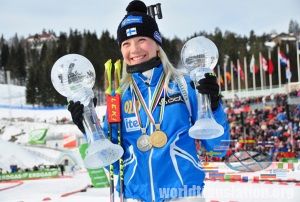 and in all disciplines taken together (overall World Cup standings). Also is conducted ranking of countries in the relay races, and in the Nations Cup standings.
and in all disciplines taken together (overall World Cup standings). Also is conducted ranking of countries in the relay races, and in the Nations Cup standings.
Second in importance biathlon competition is IBU Cup (Open Cup of Europe).
Biathlon World Championships - the biggest competition. Now the program of the World Championship consists of competitions in: 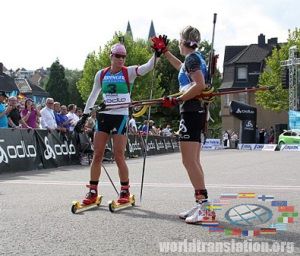 pursuit, individual race, mass start, sprint, men's and women's relay and mixed relay. Summer world championships in summer biathlon (on roller skis).
pursuit, individual race, mass start, sprint, men's and women's relay and mixed relay. Summer world championships in summer biathlon (on roller skis).
Also are conducted commercial competitions which are designed to attract viewers.
The most famous biathletes.
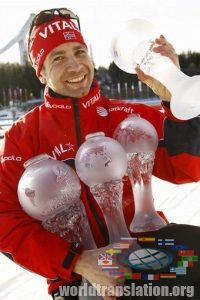 Currently the most famous and the most successful biathlete, both among men and women, the living legend - "King of the biathlon" is Norwegian Ole Einar Bjoerndalen, who continues his career to this day (he is now 38 years old). He is 6 times Olympic champion, among women most of all Olympic gold medals (3) has German biathlete Kati Wilhelm. Ole Einar Bjoerndalen
Currently the most famous and the most successful biathlete, both among men and women, the living legend - "King of the biathlon" is Norwegian Ole Einar Bjoerndalen, who continues his career to this day (he is now 38 years old). He is 6 times Olympic champion, among women most of all Olympic gold medals (3) has German biathlete Kati Wilhelm. Ole Einar Bjoerndalen  18 times won World Championships, also has 94 wins (93 of which in the biathlon and 1 in skiing) at World Cup stages, and also 6 wins in overall World Cup standings. Among women most of all wins in the World Championships has German athlete Magdalena Neuner (12 wins), aslo she has
18 times won World Championships, also has 94 wins (93 of which in the biathlon and 1 in skiing) at World Cup stages, and also 6 wins in overall World Cup standings. Among women most of all wins in the World Championships has German athlete Magdalena Neuner (12 wins), aslo she has 32 victories at World Cup stages, and most of all wins at World Cup stages and in the overall World Cup standings has Swedish biathlete Magdalena Forsberg - 6 times she became the owner of the Big Crystal Globe, and 42 times won at World Cup stages.
32 victories at World Cup stages, and most of all wins at World Cup stages and in the overall World Cup standings has Swedish biathlete Magdalena Forsberg - 6 times she became the owner of the Big Crystal Globe, and 42 times won at World Cup stages.
The most perspective active biathletes (men):
Martin Fourcade
Emil Svendsen
Andreas Birnbacher
Evgeny Ustyugov
Jakov Fak
Eugene Garanichev
Friedrich Pinter
The most perspective active biathletes (women):
Tura Berger
Darya Domracheva
Kaisa Makaryaynen
Miriam Gessner
Andrea Henkel
Olga Viluhina
Mary Doran Haber